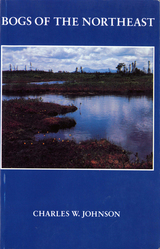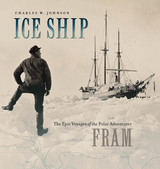4 books by Johnson, Charles W.

Bogs of the Northeast
Charles W. Johnson
University Press of New England, 1985
What makes bogs so interesting yet so misunderstood? This generously illustrated book presents many of the exciting, almost enthralling, facets of bogs--unusual plants, intricate ecological relationships, animals, myths and folklore, and the myriad history recorded in the peats. Despite the fascinating bogs hold, until now there has been no popular book that deals with them in a comprehensive yet authoritative manner. The Northeastern United States has a wonderful diversity of bogs: some are southern in nature, others are very arctic, and still others maritime. And although this is a book primarily about peatlands in New York, New Jersey, Pennsylvania, and the six New England states, it will interest a much wider audience seeking an exciting and attractive approach to these often-neglected areas of our natural heritage.
[more]

City Behind Fence
Oak Ridge, Tennessee, 1942-1946
Charles W. Johnson
University of Tennessee Press, 1981
Oak Ridge, Tennessee, was created by the U.S. government during World War II to aid in the construction of the first atomic bomb. Drawing on oral history and previously classified material, this book portrays the patterns of daily life in this unique setting.
[more]

Ice Ship
The Epic Voyages of the Polar Adventurer Fram
Charles W. Johnson
University Press of New England, 2014
In the golden age of polar exploration (from the mid-1800s to the early 1900s), many an expedition set out to answer the big question—was the Arctic a continent, an open ocean beyond a barrier of ice, or an ocean covered with ice? No one knew, for the ice had kept its secret well; ships trying to penetrate it all failed, often catastrophically. Norway’s charismatic scientist-explorer Fridtjof Nansen, convinced that it was a frozen ocean, intended to prove it in a novel if risky way: by building a ship capable of withstanding the ice, joining others on an expedition, then drifting wherever it took them, on a relentless one-way journey into discovery and fame . . . or oblivion. Ice Ship is the story of that extraordinary ship, the Fram, from conception to construction, through twenty years of three epic expeditions, to its final resting place as a museum. It is also the story of the extraordinary men who steered the Fram over the course of 84,000 miles: on a three-year, ice-bound drift, finding out what the Arctic really was; in a remarkable four-year exploration of unmapped lands in the vast Canadian Arctic; and on a two–year voyage to Antarctica, where another famous Norwegian explorer, Roald Amundsen, claimed the South Pole. Ice Ship will appeal to all those fascinated with polar exploration, maritime adventure, and wooden ships, and will captivate readers of such books as The Endurance, In the Heart of the Sea, and The Last Place on Earth. With more than 100 original photographs, the book brings the Fram to life and light.
[more]

Societies in Eclipse
Archaeology of the Eastern Woodlands Indians, A.D. 1400-1700
Edited by David S. Brose, C. Wesley Cowan, and Robert C. Mainfort
University of Alabama Press, 2001
Combines recent research with insights from anthropology, historiography, and oral tradition to examine the cultural landscape preceding and immediately following the arrival of Europeans
After establishing the distribution of prehistoric and historic populations from the northeastern Appalachian forests to the southern trans-Mississippian prairies, the contributors consider the archaeological and cultural record of several specific groups, including Mohawk and Onondaga, Monacan, Coosa, and Calusa. For each, they present new evidence of cultural changes prior to European contact, including populations movements triggered by the Little Ice Age (AD 1550–1770), shifting exchange and warfare networks, geological restriction of effective maize subsistence, and use of empty hunting territories as buffers between politically unstable neighbors. The contributors also trace European influences, including the devastation caused by European-introduced epidemics and the paths of European trade goods that transformed existing Native American-exchange networks.
While the profound effects of European explorers, missionaries, and traders on Eastern Woodlands tribes cannot be denied, the archaeological evidence suggests that several indigenous societies were already in the process of redefinition prior to European contact. The essays gathered here show that, whether formed in response to natural or human forces, cultural change may be traced through archaeological artifacts, which play a critical role in answering current questions regarding cultural persistence.
After establishing the distribution of prehistoric and historic populations from the northeastern Appalachian forests to the southern trans-Mississippian prairies, the contributors consider the archaeological and cultural record of several specific groups, including Mohawk and Onondaga, Monacan, Coosa, and Calusa. For each, they present new evidence of cultural changes prior to European contact, including populations movements triggered by the Little Ice Age (AD 1550–1770), shifting exchange and warfare networks, geological restriction of effective maize subsistence, and use of empty hunting territories as buffers between politically unstable neighbors. The contributors also trace European influences, including the devastation caused by European-introduced epidemics and the paths of European trade goods that transformed existing Native American-exchange networks.
While the profound effects of European explorers, missionaries, and traders on Eastern Woodlands tribes cannot be denied, the archaeological evidence suggests that several indigenous societies were already in the process of redefinition prior to European contact. The essays gathered here show that, whether formed in response to natural or human forces, cultural change may be traced through archaeological artifacts, which play a critical role in answering current questions regarding cultural persistence.
[more]
READERS
Browse our collection.
PUBLISHERS
See BiblioVault's publisher services.
STUDENT SERVICES
Files for college accessibility offices.
UChicago Accessibility Resources
home | accessibility | search | about | contact us
BiblioVault ® 2001 - 2024
The University of Chicago Press









